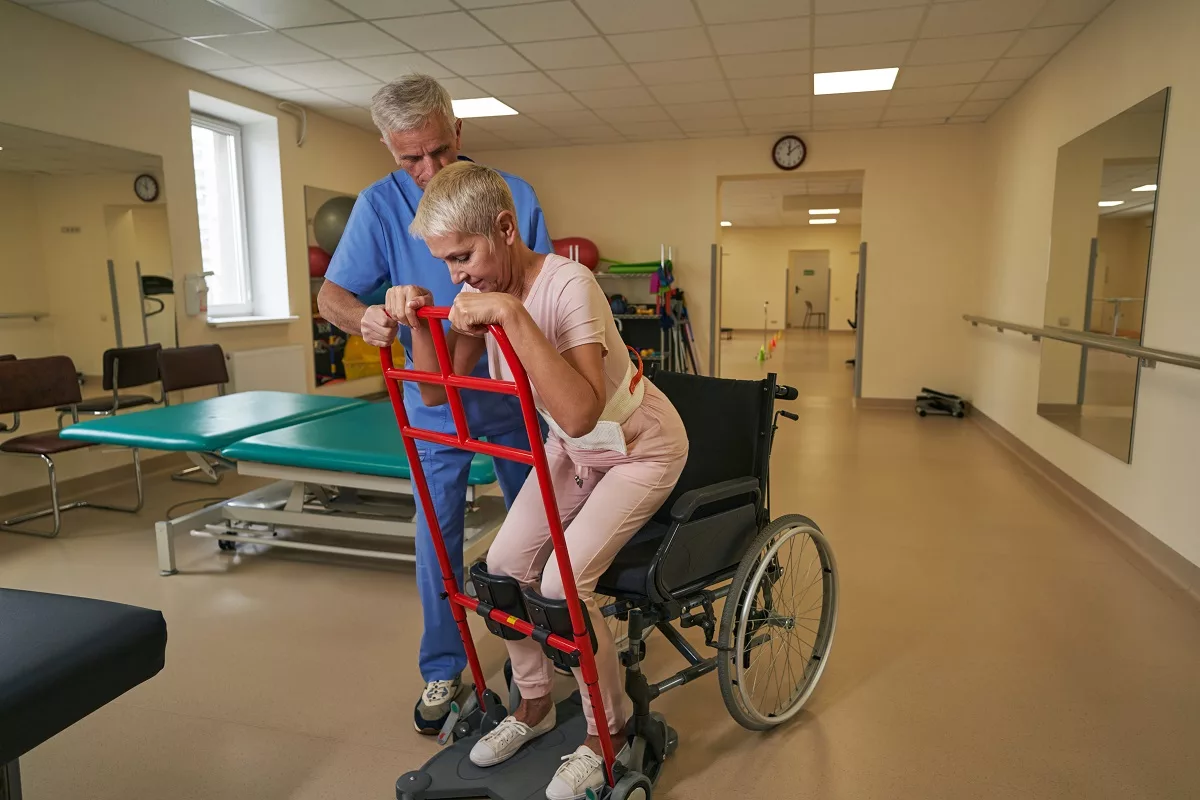A condition in which the nerve signals to the muscles are affected is called paralysis. When it occurs, people often cannot make voluntary movements. The most common causes of paralysis include strokes, spinal cord injuries, and nerve disorders (including multiple sclerosis). However, Bell’s palsy may cause facial paralysis for a short time.
Moreover, this condition may affect any part of the body. For example:
- Partial (paresis) – In such cases, you cannot move specific parts of the body.
- Complete – People with complete paralysis cannot control any muscle in the body.
In addition, this disorder can be divided into two categories based on the exact location of the injury. These include flaccid (characterized by muscle weakness) and spastic (characterized by muscles that tighten with involuntary spasms).
In general, this is a common condition that affects about 1 in 50 people in the U.S., or 5.4 million people have at least one form of paralysis. While some people may experience paralysis temporarily, which is often caused by Bell’s palsy, others may develop permanent paralysis. Usually, people with permanent paralysis cannot regain muscle control.
Types of Paralysis
There are two forms of paralysis. For example, localized paralysis negatively affects a small section of the body, including the face, hands, feet, or vocal cords, and generalized paralysis often affects a large area of the body. Thus, physicians have categorized generalized paralysis into different types based on the extent of paralysis. Check below some examples:
- Diplegia – In such cases, paralysis occurs in the same area on both sides of the body. For instance, both arms, both legs, and both sides of the face.
- Hemiplegia – This type of paralysis negatively affects one side of the body only.
- Monoplegia – Inability to move an arm or leg.
- Paraplegia – This type of generalized paralysis often affects both legs and torso (sometimes).
- Quadriplegia (tetraplegia) – This is one of the most severe types of paralysis because it affects all limbs and the torso. Commonly, people with quadriplegia cannot move from the neck down.
Symptoms
The primary symptom of paralysis is the inability to control muscles in one or multiple parts of the body. Commonly, this condition also causes a loss of sensation in the affected area. Sometimes, paralysis can be present at birth (such as from cerebral palsy). Moreover, sudden paralysis may occur due to strokes and spinal cord injuries. However, there are some conditions that cause paralysis gradually. Check below some symptoms:
- Steady loss of feeling and muscle control
- Muscle cramps
- Numbness and tingling in the limbs
If any of the previous symptoms occur, immediately contact your healthcare provider.
Causes
Commonly, people develop paralysis due to a problem with the nervous system. A part of the body’s command and communication system is called the nervous system. It works by sending signals throughout the body that give instructions on what to do. Anything that causes damage to the nervous system and affects the pathways through which signals go to the body structures and organs may cause paralysis.
In most cases, a health condition or traumatic injury causes damage to the muscle and nerve function. Spinal cord injury and stroke usually cause paralysis. Check below for other causes:
- Birth defects (such as spina bifida)
- Autoimmune disorders (including Guillain-Barré syndrome, multiple sclerosis, and others)
- Brain injuries (such as traumatic brain injury, cerebral palsy, and others)
- Neurological disorders, such as amyotrophic lateral sclerosis (ALS)
What Are The Potential Complications of Paralysis?
While this condition may negatively affect the heart rate and breathing muscles, it may also impact other body systems. Check below some complications that may occur in people with paralysis:
- Breathing problems
- Coughing
- Pneumonia
- Blood clots and deep vein thrombosis (DVT)
- Mental health problems (such as anxiety, major depressive disorder, and others)
- Sexual problems, such as erectile dysfunction (ED)
- Dysphagia (speech or swallowing issues)
- Autonomic dysreflexia (excessively high blood pressure)
- Orthostatic hypotension (low blood pressure)
- Heart problems
- Urinary incontinence or loss of bowel control
- Sepsis
- Bedsores (pressure injuries)
This document does not contain a complete list of paralysis complications. Moreover, you can consult with your healthcare provider about ways to reduce the risk or even prevent previous complications.
How to Prevent Paralysis?
Generally, one of the leading causes of paralysis is spinal injuries. Check below some tips that may help reduce the risk of spinal injuries:
- Wear a seatbelt – It is very important to make sure you are using car seats or booster seats properly.
- Regularly check water depths before diving
- Use protective equipment, especially when participating in sports or activities. For instance, a helmet, cushioning mats, and others.
- Do not move someone who may have a head, neck, or spine injury.
Diagnosis
First, doctors perform a physical examination to check for irregularities linked to the disease. Thereafter, they may ask some questions about your symptoms and medical history. However, to confirm this condition, physicians may perform some tests. These include:
- X-ray – It helps show broken bones that may cause nerve injuries.
- Other imaging tests – For example, a CT (computed tomography) scan or MRI (magnetic resonance imaging) to check for stroke, brain injury, or spinal cord injury.
- Myelogram – This is a specific test that may identify spinal cord and nerve injuries.
- Electromyogram (EMG) – This test is often performed by doctors to check the electrical activity of the nerves and muscles.
- Spinal tap (also called lumbar puncture) – During this procedure, doctors will take a small sample of the spinal fluid for testing. It helps detect inflammation and health conditions such as multiple sclerosis (MS).
Treatment
While temporary paralysis caused by Bell’s palsy often does not need treatment, if you develop permanent paralysis, it cannot be cured. Generally, doctors recommend physical, occupational, and speech therapy for people with paralysis. These therapies often help accommodate paralysis and improve function. However, doctors may also recommend other treatments based on the type and cause of paralysis. Check below some examples:
- Adaptive equipment – It helps you to feed yourself or drive.
- Assistive equipment – In more severe cases, doctors may recommend scooters, crutches, canes, or wheelchairs.
- Prosthetic or orthostatic devices (including braces)
- Voice-activated technology for phones, computers, or lighted systems
In addition, your physician may also recommend a treatment to relieve complications caused by paralysis.
Frequently Asked Questions
When should I see my healthcare provider?
Immediately call 911 or go to the nearest emergency room (ER) if any of the following symptoms occur. Examples include:
- Problems with breathing, swallowing, or speaking
- Muscle weakness that does not go away
- Sudden inability to control the muscles
- Tingling or numbness in arms or legs
What is the cause of paralysis?
There are multiple factors that may cause paralysis, including injuries, diseases, and genetic disorders. The most common causes of paralysis are stroke and spinal cord injuries. For more details, discuss it with your doctor.
What are the types of paralysis?
In general, there are several types of paralysis. These include:
- Monoplegia
- Hemiplegia
- Paraplegia
- Quadriplegia
Ask your healthcare provider if you have additional questions.




